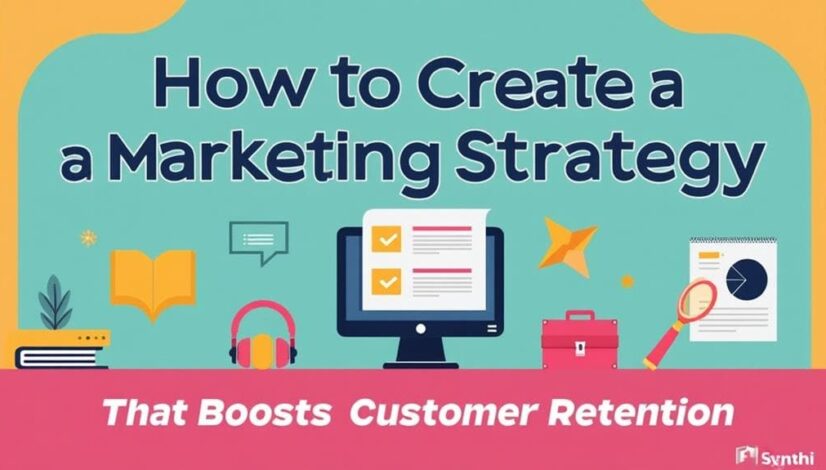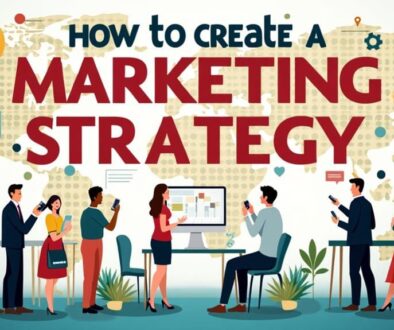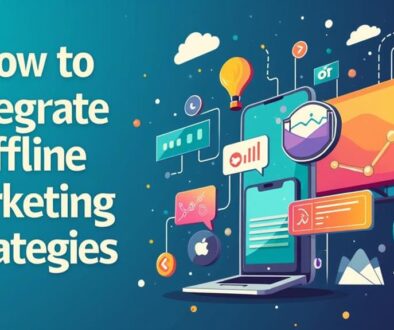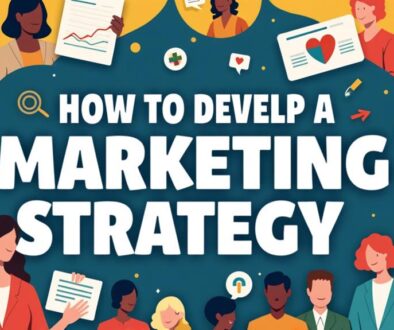How to Create a Marketing Strategy That Boosts Customer Retention
To create a marketing strategy that enhances customer retention, start by understanding customer needs through demographic analysis and journey mapping. Develop a unique value proposition to differentiate your brand, complemented by personalized marketing efforts that engage customers effectively. Implement targeted loyalty programs to foster long-term relationships and utilize customer feedback to refine your approach dynamically. Leverage social media to build community and analyze customer behavior to identify retention drivers. By integrating these strategies, you can establish a robust framework for retaining customers and creating lasting loyalty while uncovering further insights essential for success.
Key Takeaways
- Understand customer demographics and map their journey to identify pain points and enhance tailored marketing efforts.
- Develop a unique value proposition that differentiates the brand and resonates with customer needs through effective storytelling.
- Implement personalized marketing strategies using behavioral triggers and predictive analytics to engage customers and build loyalty.
- Design loyalty programs that foster repeat business and long-term relationships through gamification and referral incentives.
- Collect and analyze customer feedback and behavior metrics to adapt strategies and improve retention efforts continuously.
Understand Your Customer Needs

Understanding your customers' needs is the cornerstone of any successful marketing strategy. By examining customer demographics and employing effective market segmentation, businesses can tailor their offerings to specific groups, greatly enhancing user experience.
The customer journey, from awareness to post-purchase evaluation, must be meticulously mapped to address pain points that arise at each stage. Identifying these challenges allows brands to create solutions that foster an emotional connection with their audience.
In today's rapidly evolving landscape, utilizing feedback loops is essential for continuous improvement. Gathering real-time insights from customers not only shapes product development but also refines brand perception. By actively engaging with consumers, businesses can guarantee their offerings align with market demands and promote a sense of freedom within the purchasing process.
Moreover, conducting a thorough competitive analysis helps in recognizing industry trends that may influence customer preferences. Understanding both your audience and your competition facilitates a responsive strategy, lamenting the need for standard approaches. Instead, it encourages innovative thinking that speaks directly to consumer desires.
Ultimately, fostering a deep understanding of customer needs enables companies to create more meaningful interactions, assuring that marketing remains agile and relevant. By focusing on emotional connections and pragmatic solutions, brands can cultivate loyalty and retention—key drivers for long-term success.
As a result, investing time and resources in understanding customers is not merely a strategic advantage; it is a necessity in today's dynamic marketplace.
Develop a Unique Value Proposition
Establishing a unique value proposition (UVP) is a fundamental step in differentiating a brand within a competitive marketplace. A compelling UVP resonates with the target audience, clearly articulating why a brand stands out against competitors. This requires thorough competitor analysis, identifying key differentiators that can enhance market positioning.
Effective value communication guarantees that the unique offerings are not only understood but also appreciated by potential customers. This encompasses understanding customer perception and aligning the UVP with their needs, desires, and pain points. By focusing on benefits rather than mere features, businesses build brand loyalty that fosters an emotional connection with their audience.
Moreover, successful UVPs are adaptable to evolving market trends, allowing brands to pivot their pricing strategy or introduce product innovations as necessary. Service excellence also plays a significant role; a robust UVP should encapsulate the promise of an exceptional customer experience, reinforcing the brand's commitment to quality and satisfaction.
Utilizing effective brand storytelling gives life to the UVP, turning abstract concepts into relatable narratives that engage customers on a personal level. These narratives not only showcase the brand's values but also emphasize how it fulfills the audience's needs and aspirations.
In a landscape crowded with choices, a distinct UVP not only positions a brand effectively but cultivates a loyal customer base enthusiastic to advocate for and return to the brand, ultimately enhancing retention efforts and sustaining growth.
Utilize Customer Feedback

Customer feedback serves as a critical compass for shaping a marketing strategy that resonates with the target audience and drives business growth. By systematically implementing customer satisfaction surveys, businesses can gather invaluable insights into consumer preferences and behaviors. This data forms the backbone of effective feedback loops, enabling organizations to continuously refine their offerings based on real-time input.
Leveraging sentiment analysis tools allows brands to discern emotional reactions to their products or services, enriching their understanding of customer perceptions. User experience evaluations further enhance this understanding, guiding firms through the complexities of the customer journey. This is where customer journey mapping becomes instrumental; it helps visualize touchpoints and identify areas ripe for improvement.
To effectively respond to the wealth of feedback obtained, businesses must develop robust feedback response strategies. This includes addressing product improvement suggestions promptly and transparently, which not only enhances customer loyalty but also demonstrates a commitment to user satisfaction. Additionally, conducting regular customer experience audits guarantees ongoing alignment with consumer expectations.
Incorporating these elements into a marketing strategy not only bolsters customer retention but also cultivates a culture of innovation. By embracing customer feedback, companies can pivot as needed, thereby creating an agile and responsive business environment.
As consumers increasingly value brands that listen and adapt, utilizing feedback becomes essential for maintaining relevance and fostering long-term loyalty. Embracing this strategy not only nurtures the customer relationship but also propels business success in an ever-competitive landscape.
Personalize Marketing Efforts
In today's competitive landscape, tailoring marketing efforts to individual preferences can increase engagement rates by up to 80%. To achieve this, businesses must leverage customer segmentation techniques that enable them to identify distinct groups within their audience. By implementing targeted campaigns, brands can deliver tailored experiences that resonate with the unique desires of each customer segment.
Emotional connections are a powerful force in consumer behavior, and marketing strategies that incorporate predictive analytics can enhance these bonds. By analyzing historical data and consumer behavior patterns, companies can make personalized recommendations that actively engage their customers. This approach is further amplified by utilizing dynamic content, which adapts based on a user's interactions or preferences, ensuring that communications remain relevant and timely.
Additionally, integrating behavioral triggers allows for customization of offers that closely align with individual customer journeys. For instance, a recent web browsing session or abandoned cart could prompt an immediate, personalized follow-up that addresses specific interests. Such engagement strategies not only present opportunities for increased conversions but also cultivate a broader sense of loyalty.
Ultimately, personalizing marketing efforts is not merely an option; it's a necessary evolution in achieving customer retention. Clients are increasingly looking for customized interactions that reflect their individual preferences and needs. By embracing this paradigm shift, brands can create meaningful dialogues and foster long-term relationships, thereby empowering customers while driving sustained business success.
Implement Loyalty Programs

Implementing loyalty programs can serve as a strategic pillar in a brand's marketing strategy, not only driving repeat business but also enhancing customer lifetime value. A well-executed loyalty program encourages customers to engage more deeply with a brand, resulting in increased frequency of purchases and overall satisfaction.
To design an effective loyalty program, businesses should first consider the various loyalty program types available—points-based, tiered, or cash-back models—tailoring their reward structure design to what resonates with their target audience.
Employing customer engagement tactics such as personalized communications can further drive interaction, making customers feel valued and understood.
Next, program promotion strategies should be developed to guarantee widespread awareness and participation. Leveraging technology utilization, such as mobile apps or digital wallets, can simplify the tracking and redemption of rewards, enhancing accessibility and convenience for users.
Integration of the loyalty program into the overall retention strategy requires careful consideration of customer segmentation approaches. By understanding diverse customer needs and behaviors, brands can create more targeted incentives that reflect current loyalty program trends.
Additionally, employing incentive alignment strategies guarantees that rewards offered not only motivate customers but also align with the business's long-term goals.
Foster Strong Customer Relationships
To foster strong customer relationships, businesses must prioritize personalized communication efforts that resonate with individual preferences.
Engaging through social media allows for meaningful interactions, reinforcing brand loyalty and community engagement.
Additionally, effectively highlighting loyalty program benefits can enhance customer satisfaction and retention, solidifying these relationships over time.
Personalize Communication Efforts
Effective communication serves as the backbone of strong customer relationships, enabling brands to connect with their audiences on a deeper level. To enhance customer retention, companies must embrace personalized communication strategies, leveraging customer segmentation to understand the unique needs and preferences of their audiences.
By categorizing customers based on distinct traits—such as demographics, purchase history, and behavior—brands can create targeted outreach that resonates with each group.
Tailored messaging is essential for establishing a bond of trust and loyalty. When customers receive relevant content that speaks directly to their interests, they feel valued and understood, which fosters a sense of belonging. For instance, a personalized email that references a customer's past purchases can greatly increase engagement rates compared to generic correspondence.
Moreover, brands can utilize data analytics to refine their messaging continually, ensuring it remains aligned with evolving customer sentiments. This commitment to individualized attention not only enhances user experience, but it also empowers customers to exercise their preferences freely.
In this landscape of personalized communication, brands can cultivate enduring relationships that are crucial for long-term success and market competitiveness.
Engage Through Social Media
In today's digital landscape, leveraging social media has become an essential strategy for fostering strong customer relationships. Engaging customers through platforms allows brands to build community and enhance loyalty.
Implementing interactive polls can spark dialogue, giving customers a voice while collecting insights that inform future strategies. Similarly, social media contests incentivize participation and generate enthusiasm around your brand, reinforcing a sense of belonging.
User-generated content not only amplifies authenticity but also encourages brand advocacy, as customers become advocates sharing their positive experiences.
Additionally, developing influencer partnerships can expand your reach, tapping into established trust within niche audiences.
It's vital to adopt platform-specific strategies to maximize impact; each platform has unique dynamics that can enhance visual storytelling and community engagement.
Hashtag campaigns can effectively unify conversations, making it easier to monitor sentiment through social listening techniques.
Loyalty Program Benefits
Frequent interactions through loyalty programs can greatly enhance customer relationships by fostering a sense of appreciation and belonging. A well-designed loyalty program not only rewards customers but also nurtures persistent customer engagement, leading to increased retention.
Here are key benefits of implementing a robust loyalty program:
- Program Tiers: By creating tiered membership levels, businesses can incentivize customers to regularly engage and elevate their spending to access enhanced loyalty rewards.
- Exclusive Offers: Tailoring exclusive offers to loyal customers reinforces their sense of value and encourages ongoing participation in the loyalty program.
- Gamification Strategies: Utilizing gamification strategies can transform mundane transactions into interactive experiences, boosting overall customer satisfaction and emotional investment.
Incorporating referral incentives can further broaden the customer base, as satisfied patrons advocate for your brand's membership benefits.
Effective retention tactics are essential in cultivating long-lasting relationships. By aligning your loyalty program with your customers' desires, you empower them with the freedom to choose how they engage, ensuring satisfaction that translates into sustained loyalty.
Elevate your strategy and witness the profound impact of customer loyalty programs on fostering strong, enduring relationships.
Leverage Social Media Engagement
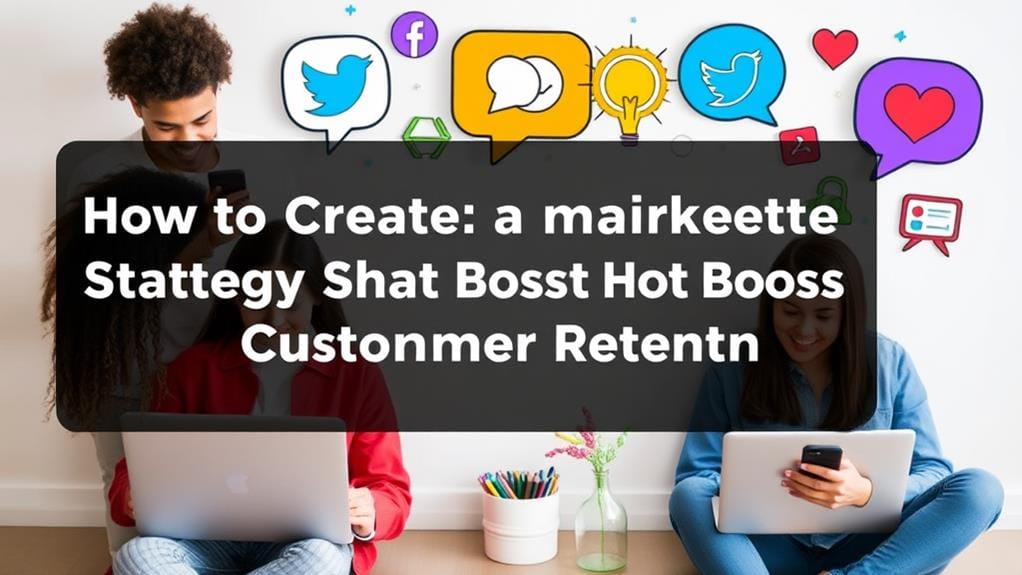
Consistently leveraging social media engagement is vital for brands aiming to enhance their visibility and strengthen customer relationships. In today's fast-paced digital landscape, staying attuned to social media trends allows brands to align their strategies with evolving consumer behavior.
Audience segmentation plays an important role here; by tailoring content to specific groups, brands can create messages that resonate deeper, thereby increasing engagement metrics.
Strategic content scheduling guarantees that posts reach audiences at peak times, enhancing visibility and interaction. Furthermore, visually appealing and authentic content, such as user-generated content and visual storytelling, not only captures attention but fosters a sense of community building among followers.
When brands invite customers to share their experiences, they cultivate brand advocacy, reinforcing loyalty and trust.
To amplify reach and credibility, consider forming influencer partnerships. Collaborating with influential voices in your niche effectively expands your audience and solidifies your brand's reputation. Engaging with these influencers can inspire a dynamic exchange between the brand and its community, ultimately enhancing customer retention.
Additionally, platform optimization guarantees that content stands out in crowded feeds, driving deeper engagement.
Brands should focus on metrics to assess their efforts continually; understanding which posts resonate most can guide future strategies.
Analyze Customer Behavior Data
Analyzing customer behavior data is essential for refining your marketing strategy and ensuring targeted engagement.
Employing effective data collection methods enables you to capture valuable insights, while behavior pattern analysis helps identify trends and preferences that can enhance customer satisfaction.
Data Collection Methods
Understanding customer behavior is essential for businesses looking to optimize their marketing strategies. To effectively gauge what resonates with your audience, various data collection methods can be employed:
- Surveys and questionnaires: These tools gather quantitative data on customer preferences and satisfaction.
- Social listening: Monitoring online conversations allows businesses to understand customer sentiments in real-time.
- Website tracking: Analyzing how visitors navigate your site can reveal insights into their interests and pain points.
Other valuable methods include focus groups and customer interviews, which facilitate in-depth discussions, providing qualitative insights that often numbers alone cannot capture.
Analyzing online analytics alongside transaction data reveals purchasing trends and behaviors, whereas demographic profiling helps to pinpoint specific audience segments.
Feedback forms can continuously enhance your offerings, while sales data offers a historical perspective on customer loyalty and preferences.
Thoroughly utilizing these techniques allows businesses to form a holistic view of customer behavior.
Behavior Pattern Analysis
Through the lens of behavior pattern analysis, businesses can convert raw customer data into actionable insights that drive strategic marketing efforts. By implementing sophisticated behavior tracking tools, companies can monitor how customers interact with their offerings, facilitating precise customer segmentation strategies.
This segmentation enables tailored marketing approaches, enhancing engagement metrics analysis and leading to improved customer experiences.
Employing predictive analytics techniques allows businesses to anticipate customer needs and tailor services accordingly. Through effective customer journey mapping, organizations can identify critical touchpoints where interventions could greatly enhance retention rate optimization.
An integrated approach leveraging loyalty trends assessment can help reinforce relationships with customers, driving them towards brand loyalty.
Behavioral insights application offers the capacity to predict potential churn through advanced churn prediction models, ensuring proactive measures are taken to retain at-risk segments.
Meanwhile, data visualization methods transform complex data into clear, actionable formats that empower decision-makers to understand patterns effortlessly.
Create Compelling Content
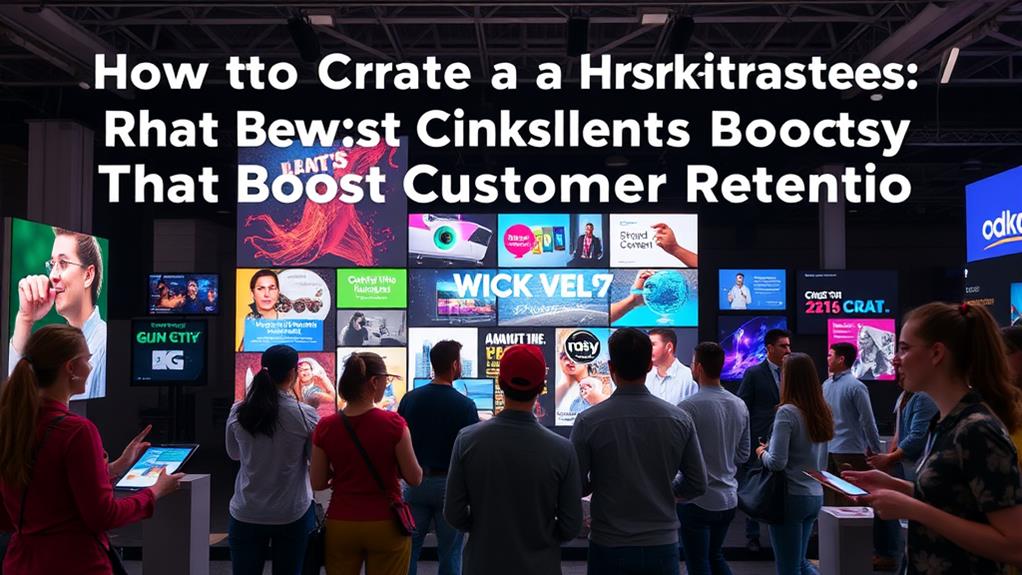
Creating compelling content is crucial for capturing attention and fostering engagement in any marketing strategy. To effectively connect with your audience, you must leverage a variety of content formats that resonate with their preferences. Storytelling techniques can cultivate an emotional connection, encouraging consumers to invest in your brand beyond transactional relationships.
Consider the following key elements in your content creation process:
- Visual Appeal: Use striking visuals and multimedia integration to enhance your narrative, making complex ideas more digestible.
- Educational Resources: Provide value through informative content that empowers your audience, positioning your brand as a thought leader in your industry.
- User Generated Content: Encourage and showcase contributions from your customers, which can foster community engagement and amplify brand trust.
Maintaining a consistent brand voice is critical, as it builds recognition and loyalty. Your audience should feel an authentic connection to your message, driving deeper engagement.
Incorporating content distribution strategies is equally important; optimize for various platforms to guarantee your compelling content reaches its intended audience. Tailored distribution increases the likelihood of engagement, creating a dynamic conversation with your clientele.
Ultimately, crafting compelling content is about enhancing audience engagement and establishing an emotional bond with your customers. When they perceive your brand as a source of value, they are more likely to remain loyal, ultimately boosting customer retention and fostering long-term relationships.
Monitor and Adjust Strategies
To optimize marketing effectiveness, it is essential to analyze key metrics that reveal how well strategies are performing.
Implementing A/B testing allows for a data-driven comparison of tactics, enabling marketers to identify what resonates best with their audience.
Analyze Key Metrics
Tracking key metrics is vital for any marketing strategy, as it allows businesses to gain insights into performance and effectiveness. Understanding these metrics is critical for fostering customer retention and optimizing marketing efforts.
Key metrics to analyze include:
- Churn Rate: Indicates the percentage of customers lost over a specific period.
- Satisfaction Scores: Measures customers' contentment with products or services.
- Repeat Purchases: Tracks how often customers return to buy again.
Employing retention metrics, such as engagement levels and referral rates, provides a thorough view of customer behavior. Additionally, using cohort analysis enables organizations to segment customers by behavior and preferences, facilitating targeted marketing strategies.
Implementing feedback loops guarantees continuous improvement based on direct customer insights, while segmentation strategies allow businesses to address diverse needs and increase satisfaction scores.
Ultimately, aligning these metrics with customer lifetime value enhances focus on long-term retention objectives. By actively monitoring key performance indicators and adapting strategies accordingly, businesses can not only reduce churn rates but also cultivate loyal customer bases that contribute to sustainable growth and freedom to innovate their offerings.
Implement A/B Testing
Utilizing A/B testing is vital for refining marketing strategies, enabling businesses to identify what resonates best with their target audience. By employing A/B testing methods, companies can strategically compare two or more variations of marketing materials to determine the most effective option through rigorous testing metrics. This approach empowers marketers to enhance conversion rate optimization by focusing on audience targeting with precision.
Effective A/B testing begins with hypothesis formulation, where specific assumptions about user preferences are proposed. Following the establishment of these hypotheses, test group segmentation allows for targeted user experience testing, ensuring that the variations reach accurately defined demographics.
Additionally, multivariate testing can be employed to analyze several elements simultaneously, providing insights on complex interactions between variables. The process of result analysis is vital, as it enables marketers to make data-driven decisions based on empirical evidence rather than speculation.
Iterate Based on Insights
Monitoring and adjusting strategies based on insights is essential for any effective marketing endeavor. In a dynamic landscape marked by evolving market trends and shifting consumer preferences, iterating based on valuable insights guarantees that your marketing strategy remains relevant and impactful.
To facilitate this process, consider focusing on the following pivotal aspects:
- Retention Metrics: Analyze data to understand what drives customer loyalty and satisfaction.
- Customer Segmentation: Tailor your strategies based on diverse customer profiles throughout their unique journey.
- Competitive Analysis: Stay attuned to competitors' moves to refine your position in the market.
Harnessing marketing automation and advanced analytics empowers you to monitor communication channels effectively and adapt your content strategy and engagement tactics dynamically.
Cultivating brand loyalty requires creating a feedback loop where insights not only inform decision-making but also enable proactive adjustments.
In a world where customers value personalized interactions, continuously iterating based on insights helps you meet their needs more effectively, fortifying customer retention.
Commit to this iterative process to elevate your marketing strategy, affirming your brand's commitment to delivering exceptional value and quality experiences.
Frequently Asked Questions
What Tools Can Help Us Analyze Customer Behavior Effectively?
To effectively analyze customer behavior, leveraging behavior analytics tools is paramount. These tools provide insights into the customer journey, enabling organizations to track interactions and identify patterns.
Options such as Google Analytics, HubSpot, and Mixpanel allow businesses to capture data at every touchpoint, facilitating a deeper understanding of customer preferences and tendencies.
How Often Should We Update Our Marketing Strategies?
In the constantly changing landscape of marketing, updating strategies is akin to calibrating a navigational compass.
Frequency assessment should occur quarterly, allowing for timely adjustments to the dynamic market conditions.
Strategy adaptation must align with both customer feedback and emerging trends, ensuring alignment with the desires for autonomy and relevance.
What Budget Is Needed for Effective Customer Retention Marketing?
Determining the budget needed for effective customer retention marketing requires a strategic assessment of your goals and existing customer data.
A well-allocated budget should encompass diverse retention tactics, such as personalized communication and loyalty programs, to maximize impact.
Typically, dedicating 5-10% of your overall marketing budget towards these initiatives can yield substantial returns, fostering long-term relationships with customers and promoting brand loyalty in an increasingly competitive marketplace.
How Can We Identify Our Target Audience Accurately?
Research indicates that companies using demographic profiling and audience segmentation increase marketing effectiveness by 20%.
To identify your target audience accurately, start by analyzing demographic data such as age, gender, and income levels.
Utilize psychographic factors, including interests and values, to further refine your segments.
This strategic approach not only enhances customer understanding but also cultivates meaningful engagement, fostering a sense of community and empowerment among your audience.
What Metrics Indicate Successful Customer Retention Efforts?
Successful customer retention efforts can be gauged through several key metrics. High customer loyalty is indicated by repeat purchase rates and increased customer lifetime value.
Additionally, engagement rates, such as the frequency of interactions and participation in loyalty programs, reveal the strength of customer relationships.
Monitoring these metrics not only highlights effective strategies but also exposes areas for improvement, ensuring that businesses can create meaningful connections with their customers, ultimately fostering enduring loyalty.
Conclusion
In the domain of marketing, the adage "a bird in the hand is worth two in the bush" emphasizes the critical importance of retaining existing customers. By strategically understanding customer needs, offering a compelling value proposition, and utilizing data-driven insights, businesses can foster loyalty and enhance customer relationships. Implementing targeted marketing efforts and effectively engaging on social media further solidifies these connections. Continuous analysis and adaptation of strategies guarantee sustained customer retention, ultimately driving long-term business success.
